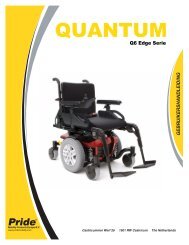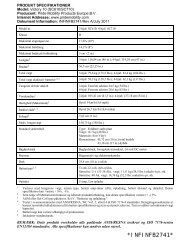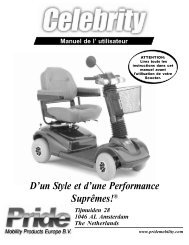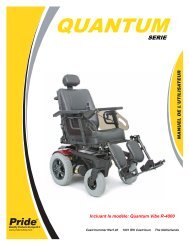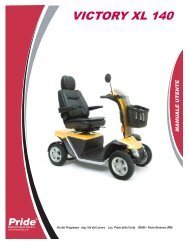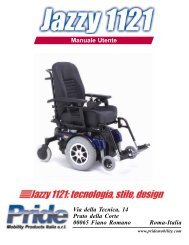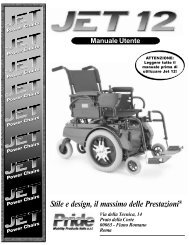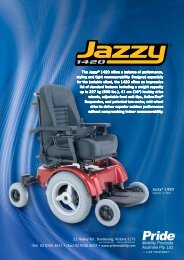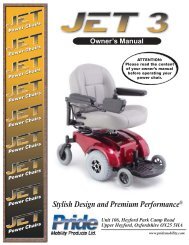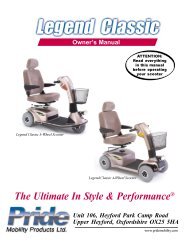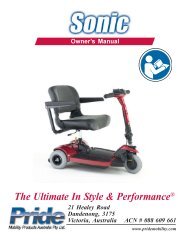electric scooters - Pride Mobility Products
electric scooters - Pride Mobility Products
electric scooters - Pride Mobility Products
You also want an ePaper? Increase the reach of your titles
YUMPU automatically turns print PDFs into web optimized ePapers that Google loves.
© AARP<br />
Product<br />
R E P O R T<br />
“Last year it finally hit<br />
me” says Diana Lord,<br />
ELECTRIC<br />
SCOOTERS<br />
a 50-year old with a disabling condition.<br />
“If I didn’t do something..., I<br />
might never visit an art gallery<br />
again.” That’s when she bought<br />
an <strong>electric</strong> scooter.
1<br />
Introduction<br />
Almost any day of the week<br />
you can find Diana Lord<br />
zipping along the paths and<br />
sidewalks of suburban<br />
Washington, DC, riding her<br />
<strong>electric</strong> scooter. It gets her<br />
around the house, but it also<br />
gets her out of the house. She<br />
goes to church, the grocery<br />
store, the community center,<br />
and the museums and art<br />
galleries in Washington, DC,<br />
via subway, on her scooter.<br />
For users, like Diana, a<br />
scooter isn’t just transportation,<br />
it’s independence.<br />
Diana’s in her early 50s, and<br />
has a disabling condition<br />
called neuromyopathy. This<br />
condition weakens both her<br />
nervous and muscle systems<br />
and prevents her from taking<br />
even a few steps. “Last year<br />
it finally hit me,” says Diana.<br />
“If I didn’t do something, I<br />
might never visit an art<br />
gallery again.” That’s when<br />
she started shopping for a<br />
scooter. Diana began by<br />
reading scooter advertisements<br />
and writing away for<br />
more information. Next she<br />
test-drove a scooter. “I was<br />
like a teenage boy with his<br />
first motorcycle,” Diana says.<br />
She settled on an indoor/<br />
outdoor scooter for $2,445<br />
and has been a satisfied user<br />
for more than a year. Diana<br />
still drives a car, sporting a<br />
scooter carrier. In reality,<br />
however, it’s the scooter that<br />
gives her the legs she<br />
by Lee Norrgard<br />
© Copyright 1995, AARP<br />
needs to go where she wants<br />
to go.<br />
Diana’s decision to buy a<br />
scooter is like those of more<br />
and more adults. Last year,<br />
approximately 30-40,000<br />
consumers purchased new<br />
<strong>scooters</strong>. Many scooter<br />
owners, according to an<br />
AARP questionnaire sent to<br />
500 member users, appear to<br />
be older. The average age<br />
was 69 years but there are<br />
also 40 year-olds and 90<br />
year- olds driving <strong>scooters</strong>.<br />
Half the scooter owners<br />
questioned in the AARP<br />
tabulation purchased their<br />
vehicles within the last two<br />
years and paid an average of<br />
$2,400. Over 60 percent<br />
drive their scooter every day,<br />
and 58 percent use it both<br />
indoors and out. Almost all<br />
users (93 percent) expressed<br />
satisfaction with their vehicles.<br />
Buyers can find plenty of<br />
new and used vehicles to<br />
choose from. There are at<br />
least twenty different manufacturers<br />
of <strong>scooters</strong>, many<br />
with different models. With<br />
all these choices, how do you<br />
make a decision?<br />
Product Report - This booklet<br />
provides information to<br />
help you decide if an <strong>electric</strong><br />
scooter might meet your<br />
needs. Up to now, very little<br />
comparative information was<br />
widely available. This product<br />
report seeks to fill an<br />
information gap with brand-<br />
name information, user comments,<br />
and suggestions. We can’t<br />
guarantee you’ll be problem free,<br />
but we’ll help you make a more<br />
informed choice. We wrote this<br />
guide for the first-time buyer.<br />
However, if this is your second<br />
or third purchase, there will be<br />
information you, too, can use.<br />
What’s an<br />
Electric<br />
Scooter?<br />
An <strong>electric</strong> scooter is a batterypowered,<br />
three or four-wheeled<br />
vehicle designed for individuals<br />
who have difficulty walking.<br />
There are <strong>scooters</strong> for indoor use,<br />
<strong>scooters</strong> for outdoor use, and<br />
indoor-outdoor <strong>scooters</strong> for use<br />
in both places.<br />
While models vary, each<br />
scooter normally comes<br />
equipped with:<br />
♦♦♦♦♦ A Metal (or in some instances,<br />
plastic) Chassis with<br />
Three or Four Inflatable tires<br />
-The tires could be soft or hard,<br />
filled with air or foam.<br />
♦ ♦ ♦ ♦ ♦ An Adjustable Seat with<br />
Armrests – The seat adjusts to<br />
fit the rider and swivels to provide<br />
access to tables and desks<br />
while seated on the scooter.<br />
AARP Product Report
♦♦♦♦♦ A Tiller with Controls -<br />
(see figure 1) The tiller is a<br />
combination steering wheel, gas<br />
pedal, and control panel. It<br />
adjusts up and down and tilts<br />
forward for easy entry. It’s<br />
bicycle-like handles steer left<br />
and right and, frequently, what<br />
appears to be hand brakes is<br />
actually the throttle. Some<br />
manufacturers call the throttle a<br />
wigwag.<br />
Mounted on top of the tiller is a<br />
console with an ignition switch<br />
(requiring a key), a speed<br />
control (high, low, or medium),<br />
a switch for forward and<br />
Winter 1995<br />
reverse, and a battery gauge<br />
displaying available power.<br />
On most <strong>scooters</strong> you won’t<br />
find driver-operated brakes<br />
on the tiller or the chassis.<br />
Instead, <strong>scooters</strong> use an<br />
automatic system called<br />
regenerative braking. The<br />
brakes automatically take<br />
hold when you release the<br />
throttle. Combined with the<br />
regenerative braking is a<br />
mechanical system, a parking<br />
brake, which holds the<br />
vehicle in place after it stops.<br />
♦ ♦ ♦ ♦ ♦ An Electric Motor<br />
with Rechargeable<br />
Batteries - Two<br />
rechargeable, lead batteries<br />
power the scooter’s <strong>electric</strong><br />
motor. Some <strong>scooters</strong> (depending<br />
upon make and model)<br />
speed along at up to eight miles<br />
an hour and some (depending<br />
upon make and model) travel up<br />
to 35 miles on a single battery<br />
charge. Your scooter’s maximum<br />
speed and range will vary<br />
not only upon make and model<br />
but also upon travel conditions.<br />
Hilly roads or bad weather, for<br />
example, slow you down and<br />
call for more battery power.<br />
With proper maintenance and<br />
care, a scooter can last<br />
2
3<br />
for years (one AARP member<br />
reports he’s still driving a<br />
1978 scooter). The most<br />
expensive repair will likely<br />
be a new set of gel cell<br />
batteries costing $180 every<br />
12 to 24 months.<br />
Most consumers (an estimated<br />
75 percent) pay for<br />
their <strong>scooters</strong> out of their<br />
own pockets. However, if it’s<br />
used indoors (at least in part),<br />
is medically necessary, and<br />
prescribed by a physician,<br />
Medicare may reimburse you<br />
for part of the cost. It will<br />
take some paperwork, however.<br />
Some private health<br />
insurance plans also cover<br />
<strong>scooters</strong>.<br />
Why a Scooter? -<br />
A scooter’s not your only<br />
choice in motorized mobility<br />
aids, but it has some distinct<br />
advantages. Chief among<br />
these is cost. New <strong>scooters</strong><br />
range from $1,800 to $5,000.<br />
Electric wheel chairs, on the<br />
other hand, are usually<br />
custom fitted and start at<br />
around $4,000, but can go as<br />
high as $15,000 to $25,000.<br />
Scooters are also more<br />
versatile. They’re used both<br />
indoors and out, depending<br />
upon the model. While you<br />
can use an <strong>electric</strong> wheelchair<br />
on sidewalks and<br />
streets, they’re generally not<br />
considered an outdoor vehicle.<br />
Types of<br />
Scooters<br />
To select the right vehicle for<br />
you, you must decide which<br />
scooter meets your driving<br />
needs. There are three types<br />
of <strong>scooters</strong>:<br />
Indoor, Outdoor, and Indoor-<br />
Outdoor<br />
Indoor <strong>scooters</strong> are smaller,<br />
three-wheeled vehicles.<br />
Manufacturers designed them<br />
to work best indoors or on<br />
paved, level ground. It’s a<br />
smaller and lighter scooter<br />
(generally less than 130<br />
pounds) and its tires won’t<br />
mark your floors. This is a<br />
front-wheel drive vehicle<br />
where the front-wheel pulls<br />
the scooter forward. Because<br />
it’s a smaller, lighter vehicle,<br />
indoor <strong>scooters</strong> turn the tight<br />
corners in your home (doorways,<br />
for example) without<br />
running into walls. They also<br />
travel shorter distances on an<br />
<strong>electric</strong> charge at slower<br />
speeds, and cost less. You<br />
will pay between $2,000 and<br />
$3,500 for a new, indoor<br />
scooter.<br />
Outdoor <strong>scooters</strong>, by<br />
contrast, weigh as much as<br />
100 pounds more than their<br />
indoor cousins. They are<br />
rear-wheel drive vehicles,<br />
where the rear wheels push<br />
you forward. Almost alloutdoor<br />
<strong>scooters</strong> have four<br />
wheels and sit higher off the<br />
ground (higher ground<br />
clearance). With their larger<br />
size, higher<br />
ground clearance, and a more<br />
powerful motor, out-door<br />
<strong>scooters</strong> climb hills, go up<br />
curbs, and travel over open<br />
ground. They’re faster, travel<br />
farther on a battery charge,<br />
and go in all kinds of weather.<br />
If you want to travel longer<br />
distances outdoors, this is<br />
your scooter. Outdoor <strong>scooters</strong><br />
also cost more ($2, 500 to<br />
$5,000).<br />
However, manufacturers<br />
didn’t design them for indoor<br />
driving. Outdoor <strong>scooters</strong><br />
can’t make sharp turns<br />
through narrow doorways. As<br />
a result, you’ll bump into<br />
walls driving indoors. Also,<br />
an out-door scooter’s tires<br />
may mark up your floors.<br />
Indoor-outdoor vehicles are<br />
a mixture of the best features<br />
of both indoor and outdoor<br />
<strong>scooters</strong>. Most are threewheeled<br />
vehicles with rearwheel<br />
drive and soft tires. A<br />
fully assembled indoor-outdoor<br />
unit weighs between 80<br />
and 150 pounds. Unlike<br />
outdoor vehicles, an indooroutdoor<br />
scooter can be readily<br />
disassembled for transport in<br />
your car’s trunk.<br />
You can drive an indooroutdoor<br />
scooter in your home.<br />
They’re harder to maneuver<br />
indoors than their smaller<br />
cousins, but much easier than<br />
outdoor <strong>scooters</strong>. You can<br />
also drive them outdoors,<br />
although indoor-outdoor<br />
<strong>scooters</strong> can’t climb curbs and<br />
hills with the power<br />
AARP Product Report
and stability of the heavier<br />
outdoor vehicles. In fact, it<br />
may be wise to avoid uneven<br />
ground or steep hills (see<br />
safety measures on page 8).<br />
Still, they meet most of the<br />
needs for indoor-outdoor use.<br />
The remainder of this guide<br />
focuses exclusively on indoor-outdoor<br />
vehicles because<br />
that’s what most consumers<br />
buy. Table 1 describes 15<br />
different indoor-outdoor<br />
<strong>scooters</strong>, each manufactured<br />
or distributed by a particular<br />
company. This table lists<br />
retail prices, maximum speed,<br />
driving range, over-all<br />
weight, and the weight of the<br />
heaviest part of each scooter.<br />
Table 2 (page 5) summarizes<br />
the results of<br />
Manufacturer Model<br />
Amigo <strong>Mobility</strong> ©<br />
Booster Electric<br />
Bruno<br />
Electric <strong>Mobility</strong>TM Fortress Scientific<br />
Genus Medical<br />
Invacare ©<br />
Rascal<br />
Leisure Lift<br />
<strong>Mobility</strong> Mfg.<br />
Ortho-Kinetics<br />
Pillar Technology<br />
<strong>Pride</strong> Health Care<br />
TM #230<br />
#2000<br />
Flyer<br />
Tri Rolls<br />
Pace Saver III Premium<br />
Bobcat<br />
#4635<br />
Blazer 2<br />
Sundancer<br />
Ranger<br />
Shoprider<br />
Suntec<br />
Winter 1995<br />
Deluxe<br />
Town & Country Sport<br />
Regal TenTM #75<br />
Safari<br />
Sunrunner TM<br />
a scooter evaluation conducted<br />
for AARP by the Institute for<br />
Technology Development (ITD).<br />
ITD combined the results of<br />
50 different trials, performance<br />
measures, and preferences<br />
under six headings.<br />
Based on the results of these<br />
measurements, ITD compared<br />
each scooter to all the<br />
others and ranked it as<br />
average, above, or below<br />
average in each category<br />
(Handling Ability, Safety<br />
Measures, Performance<br />
Trials, Features and Adjustments,<br />
Riding Comfort and<br />
Assembly/Disassembly). If<br />
the scooter scored in the<br />
average range, you will see a<br />
circle ( ). Above average<br />
Table 1<br />
Indoor-Outdoor Scooters<br />
Mfg. Retail<br />
Price<br />
$2995<br />
2995<br />
2495<br />
2795<br />
3255<br />
2950<br />
2860<br />
2350<br />
2395<br />
3295<br />
1795<br />
2495<br />
2295<br />
1995<br />
MIDI<br />
2395<br />
1As reported by the manufacturer.<br />
Weight in<br />
pounds<br />
158<br />
151<br />
154<br />
130<br />
132<br />
165<br />
153<br />
143<br />
143<br />
147<br />
134<br />
140<br />
Weight<br />
Heaviest Part<br />
85<br />
46<br />
41<br />
30<br />
55<br />
34<br />
47<br />
40<br />
38<br />
48<br />
60<br />
38<br />
124 43<br />
82 26<br />
144 37<br />
2As measured by ITD.<br />
is pictured with an upward<br />
facing pyramid ( ) and a<br />
below average ranking<br />
receives a downward facing<br />
pyramid ( ).<br />
If the scooter scored below<br />
average on safety measures,<br />
for example, does that mean<br />
it’s unsafe? No, if driven<br />
according to the<br />
manufacturer’s instructions,<br />
it should be safe. Some<br />
<strong>scooters</strong> simply perform<br />
better or are preferred by<br />
some people.<br />
There is no overall rating.<br />
Users must decide for themselves<br />
which scooter best<br />
meets their needs.<br />
The remainder of this report<br />
discusses each of these<br />
categories in more detail.<br />
Top<br />
Speed 1<br />
4.5<br />
4<br />
5<br />
5.5<br />
5<br />
5.5<br />
5.5<br />
5.2<br />
5.5<br />
4.9<br />
5.2<br />
4.5<br />
5<br />
5<br />
4<br />
Range in<br />
Miles 2<br />
25.5<br />
15.5<br />
11.5<br />
14.7<br />
24.3<br />
18.5<br />
19.8<br />
17.2<br />
19.7<br />
22.1<br />
13.4<br />
23.4<br />
15.5<br />
19.8<br />
10.3<br />
4
5<br />
Handling<br />
Ability<br />
Can I drive a scooter in crowded<br />
places?<br />
Can I get into my bath room on a<br />
scooter?<br />
Can I back the vehicle down<br />
narrow hallways?<br />
Can I park at a restaurant table and<br />
be comfortable eating dinner,<br />
seated on a scooter?<br />
All of these are questions about<br />
handling or how easily can you<br />
maneuver a scooter in tight spaces.<br />
To try to gauge each scooter’s<br />
handling ability, ITD conducted six<br />
separate trials with testers. These<br />
were:<br />
• Negotiating an obstacle<br />
course.<br />
• Turning around in a small<br />
room<br />
• Turning (90 o ) through a<br />
typical doorway<br />
• Stopping at a precise point<br />
Amigo <strong>Mobility</strong><br />
Booster Electric<br />
Bruno<br />
Electric <strong>Mobility</strong><br />
Fortress Scientific<br />
Genus Medical<br />
Invacare<br />
Leisure Lift<br />
<strong>Mobility</strong> Manufacturing<br />
Ortho-Kinetics<br />
Pillar Technology<br />
<strong>Pride</strong> Health Care<br />
Ranger<br />
Shoprider<br />
Suntec<br />
• Driving forward and backing<br />
down a narrow path, at<br />
various speeds<br />
• Pulling up to a table.<br />
Researchers clocked completion<br />
times, recorded any errors (bumping<br />
into a wall for example), and<br />
asked testers to rate each scooter’s<br />
ease of carrying out the task. ITD<br />
combined the various measurements<br />
to provide the rating under<br />
Handling for each scooter.<br />
In reading through the findings or<br />
the ratings, don’t consider that<br />
assessment to necessarily be the<br />
final word. First, although ITD<br />
conducted the trials with the rigor<br />
of scientific experiments, they base<br />
their findings on a small sample of<br />
users and <strong>scooters</strong>. Second, there<br />
are personal trade-offs to consider<br />
with each rating. Readers must<br />
always keep their own needs and<br />
wishes in mind; otherwise, you<br />
won’t find the scooter that’s right<br />
for you.<br />
Handling<br />
Ability<br />
Table 2<br />
Saftey<br />
Measures<br />
Performance Features and<br />
Trials Adjustments<br />
We don’t have enough space to<br />
discuss each measurement.<br />
Therefore, we’ll limit ourselves to<br />
the most important items.<br />
Obstacle Course – In some<br />
ways, driving a scooter is more<br />
difficult than driving a car. For<br />
example, there aren’t any marked<br />
scooter lanes in a shopping mall.<br />
Even if there were, mall walkers<br />
can appear out of nowhere, forcing<br />
you to go around them or brake.<br />
In its obstacle course, ITD sought<br />
to gauge each scooter’s ability to<br />
go around roadblocks. Researchers<br />
placed plastic pylons (the kind of<br />
cones used with road construction)<br />
on a seven foot by 38 foot path.<br />
Testers drove from one end to the<br />
other, scooting around each pylon.<br />
Without stopping, they turned<br />
around and retraced their steps.<br />
Researchers noted any errors and<br />
recorded completion times.<br />
Riding<br />
Comfort<br />
Assembly/<br />
Disassembly<br />
Key: Below Average Average Above Average<br />
AARP Product Report
The most important finding<br />
from this trial is that no matter<br />
which scooter you buy, you<br />
must exercise great care in<br />
crowded places. In two out of<br />
three trials, testers either struck<br />
a pylon or went out of bounds<br />
at least once per try. Testers<br />
driving the Pillar Blazer,<br />
Electric <strong>Mobility</strong> Rascal, <strong>Pride</strong><br />
Sundancer, and Booster Town<br />
and Country Sport did better,<br />
making fewer than one error<br />
per try. Drivers with the<br />
Amigo Deluxe, Leisure Lift<br />
Pace Saver III, Suntec MIDI,<br />
and Ortho Kinetics’ 4635<br />
<strong>scooters</strong> averaged one and one<br />
half or more errors per try.<br />
Turning - Next, let’s look at<br />
turning ability. ITD conducted<br />
two trials to measure this<br />
ability. In the first trial, (see<br />
figure 2, page 7), testers drove<br />
each scooter into a five foot by<br />
five foot room (about the size<br />
of a small bathroom or an<br />
elevator). The driver then<br />
backed-up, turned the vehicle<br />
around, and drove out, trying<br />
not to hit anything (researchers<br />
recorded bumping into walls<br />
or door ways as an error). In<br />
the second test, drivers passed<br />
through a narrow hallway and<br />
made a right-hand (90') turn<br />
through a 36 inch doorway (a<br />
standard width for many<br />
Winter 1995<br />
Scooter Evaluation<br />
AARP contracted with the ProMatura Group of the Institute<br />
for Technology Development (ITD) to evaluate 15 indooroutdoor<br />
<strong>scooters</strong> and review user feedback. ITD completed<br />
the following tasks:<br />
♦ user trials with 25 older, first-time user, female testers<br />
driving each scooter through an obstacle course, turnarounds,<br />
turns, straightaways, ramps, a grassy area, and other test<br />
runs.<br />
♦ Eight separate performance measures including climbing<br />
ramps, curbs, measuring stopping distances, and hill climbs.<br />
♦ A review of federal scooter injury files.<br />
♦ An analysis of 500 user letters and the tabulation of a user<br />
questionnaire.<br />
ITD researchers measures, timed, and evaluated the results<br />
of the user and performance trials. They queried testers about<br />
their experiences and preferences and recorded and analyzed<br />
all this information.<br />
AARP was the sole sponsor of this study. Every manufacturer/distributor<br />
was invited to participate by donating a<br />
sample indoor-outdoor product for evaluation.<br />
doors 1 ). Again, testers tried to<br />
complete the task as quickly as<br />
possible without hitting anything.<br />
According to testers, the Electric<br />
<strong>Mobility</strong>, <strong>Pride</strong>, and Pillar<br />
<strong>scooters</strong> are easier to turn<br />
around and make 90' turns.<br />
They also completed the turns<br />
in the best time and made fewer<br />
errors with these vehicles.<br />
On the other side, testers rated<br />
the Invacare Tri Rolls as the<br />
most difficult scooter to turn<br />
around. Drivers also made more<br />
errors with it and took longer to<br />
complete the exercise.<br />
Note: From the time we began the research, there have been a number of product and industry<br />
changes. Electric <strong>Mobility</strong> introduced a new Rascal 230 in 1995. The new model includes a<br />
number of product changes from the vehicle tested in this study. Fortress Scientific was purchased<br />
by Optiway Technology Inc. and has made a number of changes in the Fortress 2000.<br />
Genus Medical was purchased by Invacare, manufacturer of the Tri- Rolls, and <strong>Mobility</strong> Manufacturing<br />
went out of business.<br />
We chose to list these products even though they may no longer be manufactured, because<br />
dealers and distributors may still stock the <strong>scooters</strong>.<br />
1 Note: Many residential interior doors are only 30 inches wide<br />
Similarly, testers rated the<br />
Bruno Regal Ten as the most<br />
difficult scooter with which to<br />
make the right hand turns.<br />
They also too longer and made<br />
more errors with the Bruno.<br />
The turning trials contributed<br />
to the above-average ratings<br />
for the Electric <strong>Mobility</strong>, and<br />
Pillar <strong>scooters</strong> and the average<br />
or below-average ratings for<br />
the Invacare and Bruno <strong>scooters</strong><br />
under Handling Ability.<br />
Do the down arrows here<br />
indicate inferior products? Not<br />
necessarily. We’re back to the<br />
question of trade-offs.<br />
6
7<br />
Take a look at the ratings<br />
under Safety Measures.<br />
Here, both the Bruno<br />
Invacare rate a . Both<br />
<strong>scooters</strong> are larger, heavier,<br />
and generally have a wider<br />
turning radius (less able to<br />
make sharp turns). That<br />
Figure 2: Turnaround<br />
makes them difficult to<br />
maneuver in tight places,<br />
but it also makes them<br />
more stable and less likely<br />
to tip. The personal trade<br />
off is: If you need maneuverability,<br />
look at the<br />
Handling Ability rating<br />
and, if you need to climb hills<br />
and travel over open ground,<br />
look at the ratings under<br />
Safety Measures.<br />
Types of<br />
Scooters<br />
Can I cross a steep hill with a<br />
scooter?<br />
Can I stop when I need to with<br />
this vehicle?<br />
Can I climb a curb?<br />
These are questions about<br />
scooter safety and stability. To<br />
investigate these issues, ITD<br />
conducted six performance<br />
tests. Researchers:<br />
♦ Calibrated the angle at which<br />
a scooter begins to tip sideways<br />
♦ Evaluated sideways tip<br />
ability with the seat at various<br />
levels<br />
♦ Traveled full speed across a<br />
13 o grassy hill<br />
♦ Drove across potholes,<br />
♦ Measured stopping distances<br />
♦ Climbed 2.5, 3, and 3.5 inch<br />
curbs (most curbs are from three<br />
to six inches high)<br />
In addition, ITD reviewed the<br />
scooter accident reports filed<br />
with the federal Food and Drug<br />
Administration.<br />
Sideways Tipability -<br />
According to the FDA’s files,<br />
one in six reported accidents<br />
involves a scooter tipping<br />
over on its side. To be sure,<br />
the overall number of reported<br />
accidents is small 2 .<br />
Nonetheless, based on both<br />
the FDA reports and ITD’s<br />
findings, sideways<br />
2 Only 230 reports were filed between<br />
1988 and 1993.<br />
AARP Product Report
tipping should be a concern for<br />
indoor-outdoor scooter buyers.<br />
To compare the risks of<br />
tipping, ITD began by measuring<br />
the angles at which<br />
each vehicle begins to tip<br />
sideways (when one of the<br />
rear wheels lifts off the<br />
ground). To determine this<br />
angle, researchers slowly<br />
jacked up one side of the<br />
scooter as it sat on a plywood<br />
platform. When one of the<br />
rear tires raised up, researchers<br />
measured the angle of the<br />
incline. On average, <strong>scooters</strong><br />
begin to tip when one side of<br />
the vehicle is about seven<br />
inches higher than the other.<br />
This is approximately 16 o .<br />
The tip ability angles ranged<br />
from 14 o (one side is approximately<br />
six inches higher than<br />
the other) for the Ranger<br />
Safari to 19 o (one side is<br />
approximately eight inches<br />
higher than the other) for the<br />
Booster Electric.<br />
Next, ITD conducted three<br />
performance tests. First,<br />
researchers drove each<br />
scooter up and then across<br />
the same 13 o hill. Second,<br />
they drove across a series of<br />
five potholes that ranged<br />
from 1.5 to 3.5 inches deep.<br />
Third, researchers drove the<br />
<strong>scooters</strong> at full speed, in tight<br />
circles, on level ground, to<br />
learn how seat adjustments<br />
influence tip ability. For the<br />
circle test, they adjusted the<br />
seat to the lowest and farthest<br />
forward position and then the<br />
highest and farthest back<br />
position. In all three trials,<br />
researchers noted if<br />
Winter 1995<br />
Figure 3: Scooter on hill.<br />
the scooter tipped.<br />
Of the 15 <strong>scooters</strong>, only three<br />
successfully completed each<br />
performance test with the rear<br />
wheels planted firmly on the<br />
ground. The three <strong>scooters</strong><br />
were Leisure Lift, Bruno, and<br />
Pillar. Interestingly, ITD found<br />
that these three <strong>scooters</strong> only<br />
had average or slightly better<br />
tipability angles (16o or 17o ).<br />
Further, the scooter with the<br />
19o Comfort, for more information).<br />
If jostled too far to one<br />
side, the d-river’s weight alone<br />
might topple the vehicle.<br />
Indoor-outdoor <strong>scooters</strong> only<br />
weigh about 150 pounds.<br />
ITD’s 160 pound driver, for<br />
example, weighed more than<br />
all but one of the 15 <strong>scooters</strong> he<br />
test drove over the potholes.<br />
What do the tipping trials mean<br />
for the scooter buyer? First and<br />
foremost, if you plan to drive<br />
tipability angle tipped.<br />
regularly on open ground,<br />
Why’s that? Stability or keep-<br />
across hills, and potholes, you<br />
ing the wheels on the ground,<br />
need an outdoor scooter.<br />
is certainly related to the angle<br />
Outdoor <strong>scooters</strong> are larger,<br />
at which a scooter begins to tip.<br />
heavier, and more powerful. To<br />
However, no single factor be sure, there are significant<br />
appears to determine stability. differences among the 15<br />
Crossing a small pothole <strong>scooters</strong> tested by ITD. Gener-<br />
shouldn’t cause most <strong>scooters</strong> ally speaking, however, driving<br />
to tip. However, crossing that indoor-outdoor <strong>scooters</strong> on<br />
pothole at full speed may be a rough ground puts you at risk.<br />
jarring experience (see Riding If you must cross a hill on an<br />
8
9<br />
indoor-outdoor scooter, try to<br />
avoid steep grades. If you<br />
can’t avoid a steep hill, drive<br />
slowly, crossing it in small<br />
steps. Some <strong>scooters</strong> come<br />
equipped with anti-tipping<br />
devices on each side. These<br />
should prevent side tipovers<br />
in many instances, but they’re<br />
not a permanent fix.<br />
Stopping on a Dime –<br />
According to a number of<br />
retirement center managers,<br />
scooter accidents are accelerating<br />
in these facilities. In<br />
part, this is because more<br />
people are driving <strong>scooters</strong>,<br />
but are there other reasons? A<br />
medical journal suggests that<br />
scooter accidents relate to<br />
inadequate driver training and<br />
drivers with slowed reaction<br />
times. However, the authors<br />
reached these conclusions<br />
without looking at the <strong>scooters</strong>.<br />
ITD’s evaluation tried to<br />
take a snap shot-look at both<br />
the older driver and scooter<br />
performance in braking.<br />
In the first trial, researchers<br />
asked testers to try to stop<br />
each scooter at a certain point<br />
on a track. ITD asked testers<br />
to stop while going forward<br />
and in reverse, at medium and<br />
then at high speeds.<br />
The averages for all <strong>scooters</strong><br />
with these trials<br />
Trial<br />
Driving forward, medium speed<br />
Driving forward, high speed<br />
Driving reverse, medium speed<br />
Driving reverse, high speed<br />
Table 1<br />
were as listed in Table 3. The<br />
differences among individual<br />
<strong>scooters</strong> in these trials<br />
weren’t significant and aren’t<br />
included here. In the second<br />
test, ITD tried to determine<br />
the distance needed to stop a<br />
scooter traveling fool-speed<br />
on an incline. Here, a researcher<br />
drove each scooter<br />
full-speed, up and down a 5 o ,<br />
30 foot long ramp (a 5 o<br />
incline is equal to the slant on<br />
ramps making buildings<br />
wheelchair accessible). 3<br />
Midway up the ramp, researchers<br />
set-up an <strong>electric</strong><br />
eye to sound an alarm when<br />
the scooter crossed its beam.<br />
Just as the alarm sounded, the<br />
driver released the throttle, or<br />
the scooter equivalent of<br />
slamming on the brakes (as<br />
mentioned earlier, <strong>scooters</strong><br />
rely on regenerative brakes).<br />
After each vehicle came to a<br />
halt, researchers measured<br />
the distance from where the<br />
alarm sounded to the front of<br />
the scooter. Going up the<br />
ramp, the regenerative brakes<br />
brought the <strong>scooters</strong> to an<br />
immediate standstill. They<br />
stopped within inches of the<br />
<strong>electric</strong> eye, (each scooter<br />
actually rolled backwards a<br />
little). Going down the ramp,<br />
however, was a different<br />
story. Not one scooter<br />
Percentage Stopped Percentage Stopped<br />
On Line Within Ten Inches<br />
54<br />
36<br />
28<br />
18<br />
3 The user trials are included under the Handling Ability column in Table 1. The performance evaluation is included under the<br />
Safety Measure column.<br />
4 It’s interesting to note that both the <strong>Pride</strong> and Fortress <strong>scooters</strong> had the highest percentage of smooth stops on level ground.<br />
Nonetheless, on the 30 foot ramp, the <strong>Pride</strong> stopped about four feet from the <strong>electric</strong> eye and the Fortress over nine feet.<br />
47<br />
53<br />
49<br />
42<br />
came close to stopping on the<br />
proverbial dime. The best<br />
performers, the Bruno,<br />
Shoprider, Ranger, and <strong>Pride</strong><br />
<strong>scooters</strong>, stopped four feet<br />
from the alarm and the Fortress<br />
2000 took more than nine<br />
feet to come to a halt. Scooter<br />
manufacturers indicate the<br />
long stopping distance is a<br />
design compromise. Stopping<br />
too quickly might throw the<br />
driver forward so the rate of<br />
deceleration is slowed for a<br />
gradual stop. 4 None the less,<br />
long stopping distances can be<br />
dangerous if you’re not prepared.<br />
You should never drive<br />
full-speed down a hill, particularly<br />
in a congested area.<br />
However, for comparison<br />
purposes alone, let’s put the<br />
scooter on a 5 o sidewalk in San<br />
Francisco, instead of an indoor<br />
ramp. If the driver delayed<br />
slamming on the brakes until<br />
reaching the street corner, he<br />
or she would be in the road<br />
before the scooter came to a<br />
standstill. What do these trials<br />
mean to the scooter buyer?<br />
First, in the main, the ITD<br />
testers were close, but couldn’t<br />
stop on a line. You probably<br />
won’t either. Driving experience<br />
will surely improve your<br />
abilities, but you must always<br />
give yourself an extra margin<br />
in stopping every scooter.<br />
Second, remember that regenerative<br />
brakes appear to work<br />
fine going uphill. However, in<br />
driving down hill at whatever<br />
speed, learn the scooter’s<br />
limits.<br />
AARP Product Report
Test drive a scooter, braking as you<br />
go downhill.<br />
Manufacturers, Amigo, for<br />
example, with some models,<br />
do produce <strong>scooters</strong> with<br />
manual brakes and it could<br />
have been interesting to<br />
compare regenerative and<br />
manually controlled brakes<br />
with users. ITD reports that<br />
the testers kept looking for<br />
the brakes as they stopped.<br />
Performance<br />
Trials<br />
How many miles can I travel on a<br />
scooter?<br />
Can I climb a ramp with a<br />
scooter?<br />
How sharply can I turn the<br />
scooter?<br />
These are all questions about<br />
scooter performance or the limits<br />
of effective vehicle operations. To<br />
try to gauge scooter performance,<br />
ITD conducted six separate<br />
measurements. These were:<br />
♦ Measuring distance traveled on<br />
a fully charged battery<br />
♦ Clocking maximum driving<br />
time on a charge<br />
♦ Climbing two steep ramps<br />
(nine o and 18 o ).<br />
♦ Measuring turning radius<br />
♦ Climbing a 35 yard-long, 8 o<br />
hill<br />
Researchers clocked completion<br />
times, measured distances,<br />
and turning radiuses,<br />
and observed ramp climbs.<br />
Winter 1995<br />
Time and Distance With a<br />
Charge - Before you set off<br />
on an all-day trip through<br />
Disney World, you’ll want to<br />
know if your scooter will<br />
make it. To measure time and<br />
distance, ITD’s researchers<br />
began by charging each<br />
scooter’s batteries for the<br />
recommended 12 hours. They<br />
then loaded the vehicle with<br />
the equivalent of a 160pound<br />
driver and placed it on<br />
a treadmill-like device.<br />
Researchers set the scooter’s<br />
speed control and throttle for<br />
the fastest rate and ran each<br />
vehicle in place until it<br />
drained its batteries. ITD<br />
recorded the distance traveled<br />
and clocked the running time.<br />
The average distance traveled<br />
by all <strong>scooters</strong> was 18 miles.<br />
They ranged however, from<br />
ten to 26 miles. The average<br />
driving time was a little over<br />
four hours, but individual<br />
vehicles ranged from two to<br />
six hours. Be aware that, in<br />
some instances, ITD’s findings<br />
are higher or lower than<br />
manufacturers’ claims. The<br />
differences might be attributed<br />
to nothing more than<br />
different measurement<br />
techniques 5 . The driver’s<br />
weight, weather conditions,<br />
driving speed, and the terrain<br />
can all influence the power<br />
drain on a battery. Some<br />
<strong>scooters</strong> also use more power<br />
because they’re designed to<br />
carry heavier passengers. As<br />
a result, they don’t travel as<br />
far or as long. We report<br />
ITD’s findings for each<br />
scooter in<br />
Table 1. Match your needs<br />
with the range and power<br />
demands of these <strong>scooters</strong>.<br />
Climbing Ramps -<br />
Office buildings, schools,<br />
churches, and many other<br />
public facilities now have<br />
ramps for wheelchair and<br />
scooter accessibility. By<br />
federal law, none of these<br />
ramps should exceed 5 o . The<br />
question is, can every scooter<br />
climb them? Every manufacturer<br />
claims their products<br />
will, at a minimum, climb a<br />
5 o ramp and ITD’s tests<br />
confirmed this. Most manufacturers<br />
maintain their<br />
products do better than 5 o ,<br />
climbing 12 o or 15 o ramps<br />
and hills. To test these claims<br />
a 160 pound ITD researcher<br />
tried to climb both a 9 o and<br />
an 18 o ramp with each<br />
scooter. ITD found every<br />
scooter, including the Amigo,<br />
which only claims to be able<br />
to climb 5 o , made it up a15<br />
foot ramp set at 9 o . With the<br />
18 o ramp, which is more than<br />
three times as steep as most<br />
access ramps, every scooter<br />
except the Amigo and Genus<br />
made it up. Is it safe to climb<br />
an 18 o ramp or hill with these<br />
<strong>scooters</strong>? No. First, there’s a<br />
major safety consideration.<br />
Climbing the18 o ramp, eleven<br />
<strong>scooters</strong> tipped backwards,<br />
lifting the front wheels off<br />
the ground. Of those <strong>scooters</strong><br />
climbing the 18 o ramp, only<br />
the Leisure Lift and Booster<br />
vehicles kept their front<br />
wheels on the ground. Most<br />
<strong>scooters</strong><br />
5 For example, the Department of veterans Affairs (VA) certified the Leisure Lift scooter’s range at 22 miles or five more miles<br />
more than the ITD test noted. At least in part, the difference is connected to the fact that the scooter’s throttle was set at a<br />
slower speed in the VA test.<br />
10
11<br />
come equipped with antitipping<br />
devices on the back<br />
and this second set of wheels<br />
prevented tipping over. Even<br />
so, when the front wheel’s<br />
suspended in the air, the<br />
scooter’s balance is precarious.<br />
A shift in the driver’s<br />
weight could cause a sideways<br />
tip. It’s important to<br />
remember that no manufacturer<br />
recommended climbing<br />
18 o ramps. Second, in climbing<br />
inclines this steep, you<br />
may trip the scooter’s circuit<br />
breaker. To prevent damage,<br />
each scooter has a fuse-like<br />
device that cuts power when<br />
the motor reaches a certain<br />
temperature climbing steep<br />
grades heats up the motor.<br />
Resetting the circuit breaker<br />
restores the power, providing<br />
the engine cools down.<br />
Again, based on your driving<br />
conditions, you must decide<br />
which scooter is best for you.<br />
Be sure, however, to buy a<br />
scooter with anti-tipping<br />
wheels.<br />
Features and<br />
Adjustments<br />
Can I readily get in and out<br />
of a scooter?<br />
How easy is it to operate<br />
the controls?<br />
H ow easy is it to adjust the<br />
scooter to fit me?<br />
These are questions about<br />
scooter features and adjustments.<br />
Features include:<br />
ignitions, tillers, speed<br />
controls, throttles, seat locks,<br />
battery gauges, and brake<br />
locks. Adjustments include:<br />
tiller, seat, and armrests. To<br />
review each scooter’s features<br />
and adjustments, ITD asked:<br />
♦ Testers to express their<br />
preferences for features in<br />
one-on-one scooter comparisons<br />
♦ Testers and research<br />
assistants to rate the ease of<br />
entering and exiting, adjusting<br />
the seat and armrests adjusting<br />
the tiller, and setting the<br />
speed control.<br />
Throttles - Once you’ve<br />
turned the ignition on, your<br />
scooter starts rolling when<br />
you squeeze the manual<br />
throttle (see figure 1). The<br />
harder you squeeze, the faster<br />
the scooter goes, with in the<br />
limits set at the console<br />
(speed control). Even though<br />
the throttle may feel comfortable<br />
to operate, remember<br />
you must squeeze it as long as<br />
you’re driving. Therefore the<br />
throttle’s size, shape, texture,<br />
and ease of use are all important<br />
to driver comfort.<br />
Testers preferred accessible,<br />
large-handled throttles with a<br />
rubber or plastic covering. In<br />
one-on-one comparisons, they<br />
preferred the Fortress Scientific<br />
throttle (67 percent). Its<br />
curved, L-shaped, design<br />
made this throttle easier to<br />
reach and the handles were<br />
rubber-coated with a springy<br />
comfortable material.<br />
Following close by were the<br />
<strong>Pride</strong> (preferred 66 percent),<br />
Bruno (preferred 64 percent),<br />
and Electric <strong>Mobility</strong><br />
(preferred 64 percent). Each<br />
of these throttles was large<br />
and coated with soft rubber<br />
or plastic.<br />
Tiller – Many <strong>scooters</strong>’<br />
tillers adjust up and down,<br />
forward and backward to fit<br />
the driver. However, with a<br />
very large person, the tiller<br />
may not adjust to fit their<br />
torso. Be sure to test this<br />
before buying a scooter. Once<br />
adjusted, most users don’t<br />
alter their tillers. Along with<br />
adjustability, tillers swing<br />
forward and out of the way of<br />
entering and exiting drivers.<br />
Most of our testers, however,<br />
didn’t bother to swing the<br />
tillers forward after the first<br />
few test drives. In their<br />
opinion, this was an unnecessary<br />
bother. Testers preferred<br />
the <strong>Pride</strong> tiller (86 percent) in<br />
paired comparisons. Electric<br />
<strong>Mobility</strong> was a close second<br />
(83 percent). Testers found<br />
the latter tiller easier to<br />
adjust; however, both tillers<br />
are lightweight, and easy to<br />
raise and lower.<br />
Ignitions - Overall, testers<br />
prefer ignitions that are large<br />
and easy to use. The top<br />
choices were the ignitions on<br />
the <strong>Pride</strong> (preferred 74<br />
percent of the time) and the<br />
Shoprider (preferred 70<br />
percent). The <strong>Pride</strong> key is a<br />
two-inch long, plug-in device,<br />
similar to the audio<br />
visual plugs (banana plug)<br />
found on electronic equipment.<br />
It is large, easy to<br />
insert and remove, and<br />
audibly clicks upon insertion.<br />
AARP Product Report
The Shoprider key was<br />
similar to the size of a car<br />
key. Testers rated it highly<br />
because the key provided a<br />
good grip and was easy to<br />
handle. Testers gave the<br />
lowest rating to the <strong>Mobility</strong><br />
Manufacturing key (preferred<br />
only 24 percent of the<br />
time). This key was about<br />
the size of a thick, stubby<br />
pencil. It’s a half inch cylindrical<br />
magnet encased in a<br />
rubber cover. The key isn’t<br />
difficult to use. Rather,<br />
testers didn’t know what to<br />
do with it once they turned<br />
on the ignition (the key<br />
doesn’t remain in the ignition).<br />
The lower rating was<br />
for an inconvenience factor.<br />
Riding<br />
Comfort<br />
How comfortable is the ride<br />
on rough ground?<br />
Does the scooter start and<br />
stop smoothly and evenly?<br />
How comfortable are the<br />
throttle and tiller to use<br />
How loud is the motor?<br />
These are questions about<br />
scooter comfort or the sense of<br />
ease or enjoyment with the ride<br />
and key features. To try to<br />
measure this factor, ITD asked:<br />
♦ Testers to rate comfort riding<br />
on rough ground<br />
♦ Testers to gauge the ease of<br />
using scooter throttles and tillers<br />
♦ Research assistants to rate<br />
smoothness of scooter starts and<br />
Winter 1995<br />
♦ Research assistants to<br />
measure noise level in decibels<br />
Driving on Rough Ground<br />
- If you’ve ever driven a car<br />
on washboard gravel roads,<br />
you know the value of shock<br />
absorbers and springs. Most<br />
indoor-outdoor <strong>scooters</strong>,<br />
however, don’t come with a<br />
suspension system to level out<br />
the bumps in the road. It’s the<br />
springs and padding in the<br />
seat that cushion the driver.<br />
To rate scooter comfort on a<br />
bumpy course, testers drove<br />
each scooter for 90 seconds<br />
on a flat, mowed, grassy, but<br />
uneven surface. There weren’t<br />
any potholes but the crusty<br />
surface visibly jostled testers.<br />
Bouncing about on the grass<br />
didn’t alarm testers 78;<br />
percent said the ride was<br />
stable, but only 47 percent<br />
rated it as comfortable.<br />
The <strong>Pride</strong> and Pillar <strong>scooters</strong><br />
were the most comfortable on<br />
the grassy surface, according<br />
to testers, and the Fortress the<br />
least. The comfort extremes<br />
seemed to be focused on the<br />
seat. The rigid back on the<br />
Fortress 5 seat pinched testers<br />
as they bounced back and<br />
forth, and the padding was<br />
thin. The <strong>Pride</strong> and Pillar<br />
seats were well padded, and<br />
seemed to wrap around and<br />
almost encase the driver. The<br />
seat in effect, became a<br />
suspension system. The<br />
message to buyers is:<br />
1.Test drive the scooter on<br />
different surfaces before<br />
6 The new manufacturer of the Fortress says the seat has since been improved.<br />
buying, and,<br />
2.Make sure the seat is<br />
comfortable for you.<br />
Smooth Starts and Stops -<br />
Jerky starts and stops also<br />
jostle drivers. To evaluate any<br />
patterns of shaky starts and<br />
stops with <strong>scooters</strong>, ITD’s<br />
researchers watched testers as<br />
they accelerated and braked.<br />
With each motion, they tried<br />
to answer two questions: Was<br />
it smooth and even? Were<br />
there any jerky body movements?<br />
Overall, while driving the<br />
<strong>scooters</strong> forward, 89 percent<br />
of starts and 65 percent of the<br />
stops were rated as smooth<br />
and even. Going backwards,<br />
91 percent of the starts and 76<br />
percent of the stops were rated<br />
smooth and even. Setting the<br />
speed control at medium, the<br />
starts and stops were<br />
smoother than with the fast<br />
setting. The vehicles with the<br />
smoothest stops and starts,<br />
according to the researchers,<br />
were the <strong>Pride</strong>, Shoprider, and<br />
Leisure Lift <strong>scooters</strong>. On the<br />
other side, researchers noted<br />
that the Suntec scooter had<br />
many uneven starts and stops.<br />
Testers complained of being<br />
jostled back and forth both<br />
starting and stopping with this<br />
vehicle.<br />
Make sure you ask the same<br />
two questions with any<br />
scooter you’re interested in.<br />
Are the starts and stops<br />
smooth and even? And, am I<br />
jerked back and forth with this<br />
scooter?<br />
12
13<br />
Assembly<br />
Dissassembly<br />
Is it easy to take a scooter<br />
apart for transport?<br />
Can I lift each of the disassembled<br />
pieces?<br />
How difficult is it to put it<br />
back together?<br />
If the battery dies, can I<br />
push the scooter?<br />
All these questions relate to<br />
transporting the scooter. To<br />
investigate the ease of assembly,<br />
disassembly, and transport,<br />
ITD conducted six<br />
trials. Without using any<br />
tools, testers:<br />
♦ Removed and replaced the<br />
scooter seat<br />
♦ Adjusted the tiller (for<br />
transport)<br />
♦ Disconnected and attached<br />
battery connectors<br />
♦ Lifted the heaviest piece<br />
of the disassembled vehicle<br />
♦ Released the brake lock<br />
♦ Pushed the scooter.<br />
Testers and researchers rated<br />
each trial for ease of completion.<br />
We combined their<br />
ratings here. Researchers<br />
recorded the number of<br />
testers successfully lifting the<br />
heaviest disassembled pieces.<br />
Finally, researchers recorded<br />
the number of testers who<br />
released the brake lock and<br />
pushed the <strong>scooters</strong>.<br />
Taking it Apart and<br />
Putting it Together - each<br />
of the indoor-out-door <strong>scooters</strong><br />
disassembles<br />
into three to six pieces. These<br />
pieces could include the seat,<br />
tiller, batteries and connections,<br />
chassis, and body<br />
shroud (a cover over the<br />
motor and chassis). The<br />
ability to break down the<br />
scooter into smaller pieces<br />
permits users to transport it in<br />
their car without buying<br />
special carriers.<br />
ITD asked testers to assemble<br />
and disassemble the <strong>scooters</strong><br />
and to lift the heaviest disassembled<br />
piece. Researchers<br />
demonstrated each step, and<br />
asked testers to copy the<br />
procedure. In general, the<br />
testers completed most of<br />
these tasks. They didn’t find<br />
them to be difficult, but it<br />
wasn’t easy either.<br />
First they removed the<br />
<strong>scooters</strong>’ seats, one of the<br />
bulkier components. On<br />
average, half the testers<br />
dismounted the seats. Testers<br />
found the Suntec and Amigo<br />
seats easiest to remove (17 of<br />
the 25 dismounted the Suntec<br />
seat and 16, the Amigo). The<br />
most difficult to disassemble<br />
was the Shoprider (only one<br />
of 25 testers dismounted this<br />
seat).<br />
By comparison, readjusting<br />
the tiller for transport 7 was<br />
effortless. Testers successfully<br />
flattened the tillers<br />
against the chassis in 98<br />
percent of their attempts.<br />
Almost three fourths of the<br />
testers rated the task as easy.<br />
To successfully transport the<br />
disassembled pieces in your<br />
car, you must also be able to<br />
lift them into the<br />
trunk (about three feet off the<br />
ground) and the scooter<br />
pieces must fit in the trunk.<br />
The weight of the heaviest<br />
scooter pieces ranged from 24<br />
pounds for the Shoprider to<br />
85 pounds for the Amigo (See<br />
Table 1 for details). However,<br />
weight alone isn’t the only<br />
criteria for easy lifting.<br />
Only eight testers lifted the 24<br />
pound piece of the disassembled<br />
Shoprider. Yet, 12<br />
testers lifted the heaviest<br />
piece, 38 pounds, on the<br />
<strong>Pride</strong>. What’s the difference?<br />
The size of the heaviest piece.<br />
The Shop rider’s seat was the<br />
heaviest item on this scooter<br />
and its bulky size made it<br />
difficult for the testers to get<br />
their hands around to lift. By<br />
contrast, the heaviest piece on<br />
the <strong>Pride</strong> was the rear wheel<br />
assemblage. It was compact<br />
and provided a handle for<br />
easier lifting. (Note: There are<br />
commercial lifts to help you<br />
place the scooter in the<br />
trunk.)<br />
What do these trials mean for<br />
buyers? At least one scooter<br />
advertiser claims the disassembled<br />
pieces are so lightweight<br />
“no lifter (someone or<br />
something to hoist the pieces)<br />
is needed.” Yet, the ITD<br />
testers failed to lift the heaviest<br />
scooter pieces in three out<br />
of four attempts. A second<br />
advertising claim is that the<br />
scooter “disassembles or<br />
reassembles in seconds.” ITD<br />
didn’t time the disassembly<br />
trials, but testers succeeded in<br />
dismounting scooter seats in<br />
only half their attempts.<br />
7The Electric <strong>Mobility</strong> tiller didn’t readjust for transport. Instead, the tiller separated from the chasis. Testers found this procedure<br />
difficult<br />
AARP Product Report
Clearly there’s a contradiction<br />
between what the advertisers’<br />
claim and what the<br />
testers accomplished.<br />
Was there something unique<br />
about ITD’s testers? They<br />
were older, average age 74,<br />
but ranged from 59 to 84.<br />
However, over half said their<br />
health was good to excellent,<br />
and by all the physical<br />
measurements, they fit well<br />
within the normal range for<br />
this age group.<br />
Scooter buyers need to go<br />
beyond the advertising hype<br />
and check to see for them<br />
selves if they can assemble or<br />
disassemble the vehicle they<br />
want to buy. They should also<br />
see how long it takes and,<br />
after disassembling it, try to<br />
lift the pieces into the trunk<br />
of their car. Even if you can’t<br />
lift the heaviest pieces, a<br />
particular scooter may be the<br />
right one for you. However,<br />
know what you’re buying,<br />
not what the advertising is<br />
trumpeting.<br />
Final Thoughts<br />
Accessories - For this test,<br />
we asked each manufacturer<br />
to provide us with a sample<br />
of their baseline product. As<br />
a result, every scooter was<br />
gray in color and the least<br />
expensive seat was attached.<br />
Every manufacturer<br />
also sells a whole range of<br />
accessories to increase<br />
comfort or distance. There<br />
are devices to convert a<br />
three-wheeled scooter into a<br />
four-wheeled vehicle.<br />
Scooters<br />
Winter 1995<br />
are available in many different<br />
colors. Baskets and<br />
special carriers for canes and<br />
walkers are sold. Different<br />
seats are available in cloth<br />
and vinyl. It’s your choice in<br />
adding on to the scooter.<br />
Shopping for a Scooter -<br />
Scooters are sold through the<br />
mail, in the home, and<br />
through dealers. We suggest<br />
you begin by calling one of<br />
the manufacturers listed here.<br />
Above all, shop around and<br />
test drive any scooter on<br />
different terrain’s before you<br />
buy. You should also find out<br />
if the salesperson services<br />
what he/she sells? Ask if<br />
they’re factory trained? Find<br />
out what happens in an<br />
emergency and what kind of<br />
reputation does the seller<br />
have? And, finally, what<br />
happens when you travel<br />
with a scooter?<br />
Conclusion<br />
The choice is yours. Scooters<br />
provide the legs that many<br />
older persons need to go<br />
where they want to go. There<br />
are also differences among<br />
the various products and you<br />
may need to make some<br />
trade-offs. We suggest you<br />
look through the test results<br />
mentioned in this booklet.<br />
Give yourself plenty of time<br />
to make a decision. Remember<br />
too, the <strong>scooters</strong> we’ve<br />
listed in this guide are only a<br />
small sample of what’s<br />
available.<br />
Scooter Manufactures<br />
Listed in this booklet<br />
Amigo <strong>Mobility</strong> International<br />
6693 Dixie Hgwy<br />
Bridgeport, MI 48722<br />
(800) 821-2710<br />
Booster Electric Vehicles<br />
202 Woodward Hill RD<br />
Edwardsville, PA 18074<br />
(800) 845-9642<br />
Bruno Independent Living Aids<br />
PO Box 84<br />
Oconomowoc, WI 53066<br />
(800) 882-8183<br />
Electric <strong>Mobility</strong> Corporation<br />
1 <strong>Mobility</strong> Plaza<br />
Sewell, NJ 08080<br />
(800) 662-4548<br />
Fortress<br />
Optiway Technology INC<br />
500 Norfinch Dr<br />
Ontario, Canada McNlY4<br />
(800) 514-7061<br />
Genus Medical Inc.<br />
441 -A Applewood Crescent<br />
Concord, Ontario<br />
Canada L4K 4B4<br />
(800)567-9153<br />
lnvacare Corporation<br />
PO Box 4028<br />
Elyria, OH 44036<br />
(800) 333-6900<br />
Leisure Lift Inc.<br />
1800 Merriam Lane<br />
Kansas City, KS 66106<br />
(800) 255-0285<br />
Ortho-Kinetics<br />
PO Box 1647<br />
Waukesha, WI 53187<br />
(800) 558-7786<br />
Pillar Technology Inc.<br />
417 Main ST<br />
Neodesha, KS 65020<br />
(316) 325-2629<br />
<strong>Pride</strong> Health Care Inc.<br />
71 South Main Street<br />
Pittston, PA 18640<br />
(800) 457-5348<br />
Ranger All Season<br />
Corporation<br />
PO Box 132<br />
George, IA 51237<br />
(800) 225-3811<br />
Shoprider<br />
13880 Mayfield Place<br />
Richmond, British Columbia<br />
Canada V6V 2E4<br />
(604) 273-5173<br />
Suntec Systems<br />
5001 Joerns Drive<br />
Stevens Point, WI 54481<br />
(800) 643-4515<br />
14
D15979 l (1195)<br />
American Association of Retired Persons<br />
601 E Street, NW l Washington, DC 20049<br />
Other Product reports in this series are:<br />
Canes D14916<br />
Life Insurance for Older Adults D14139<br />
Manufactured Housing D15599<br />
Personal Emergency Response Systems D12905<br />
Pre-Paying Your Funeral D13188<br />
Walkers D14390<br />
Wheelchairs D14049<br />
They can be ordered by writing on a postcard to AARP Fulfillment,<br />
601 E Street, NW Washington, DC 20049<br />
Be sure to include the stock number.<br />
Allow six to eight week for delivery.<br />
Product Report: Electric Scooters was produced by the American Association of Retired Persons<br />
as an educational service to members and other older persons.





